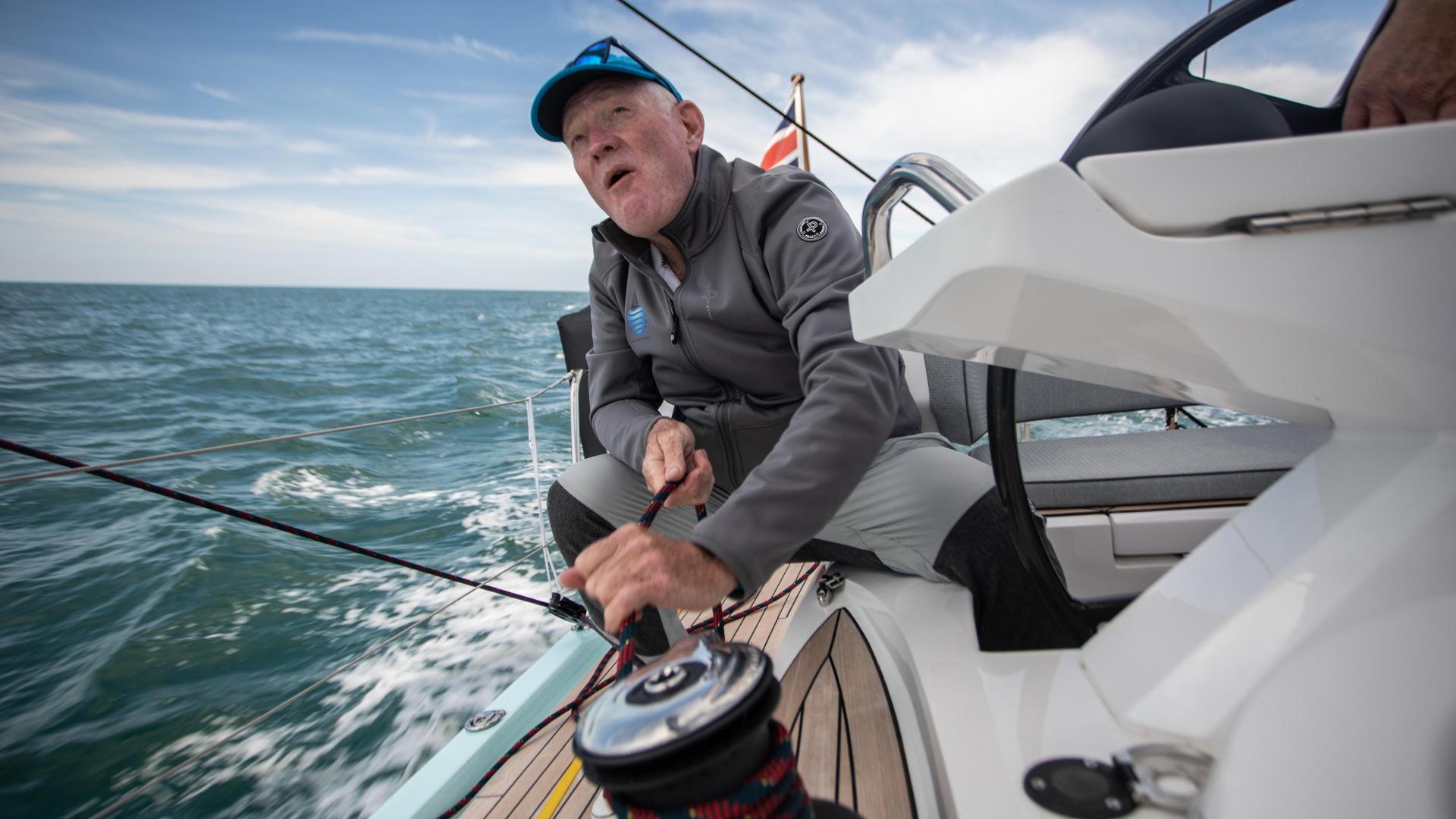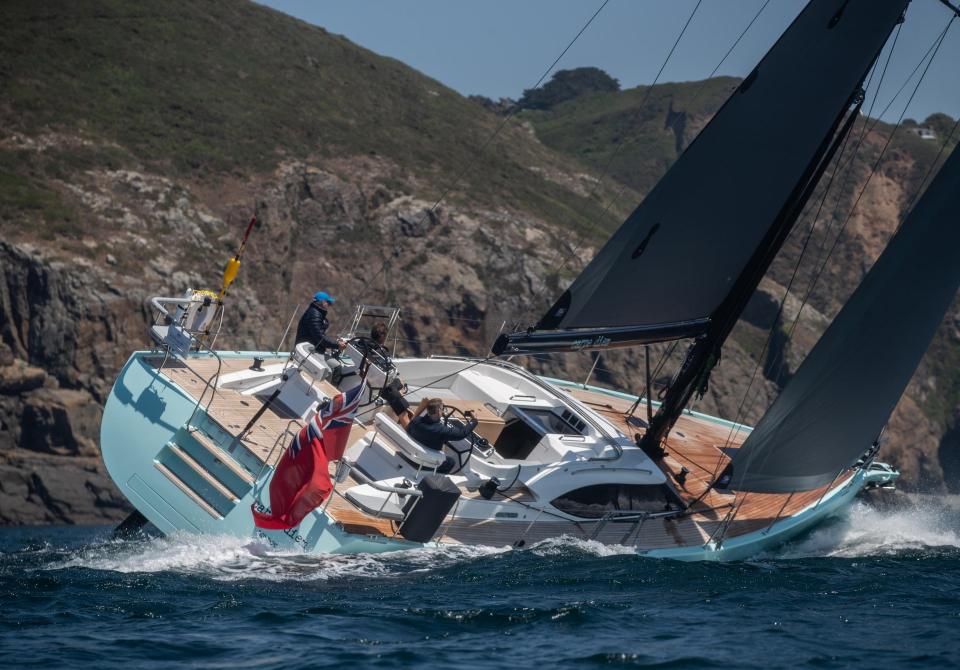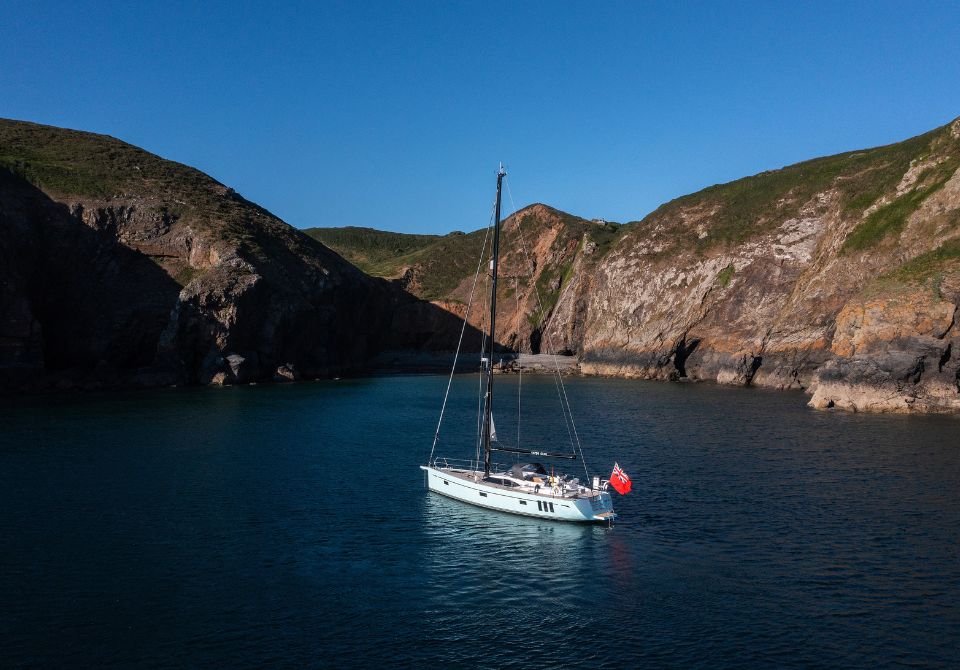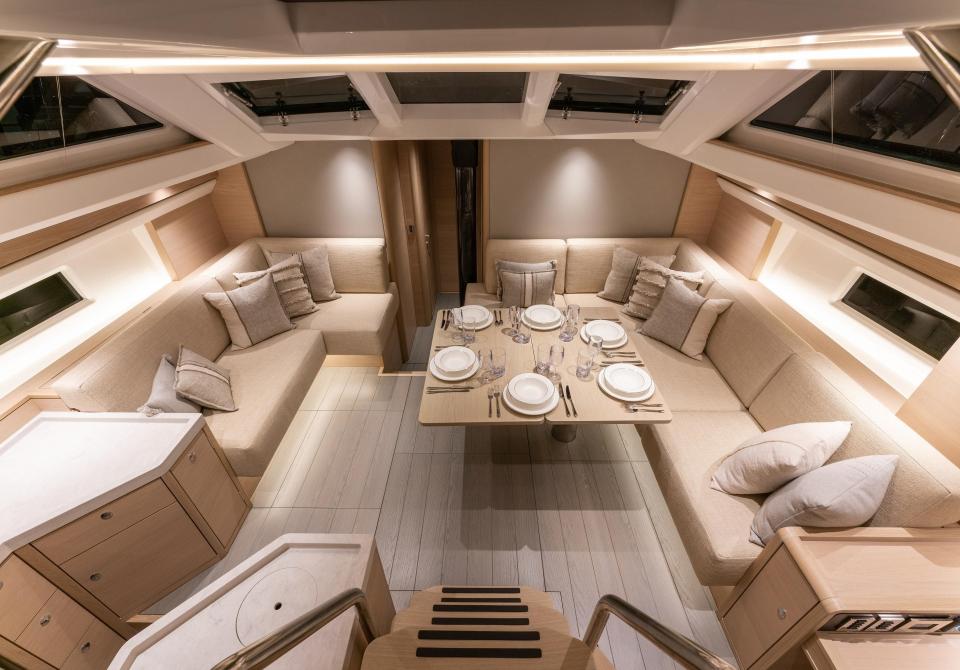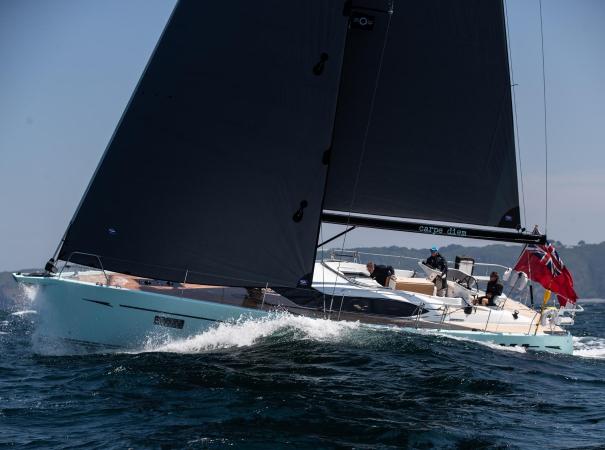It might seem odd not to start with this, after all, Oyster Chief Commercial Officer, Paul Adamson, was aboard and has been close to this project from its early beginnings. Asking him at the outset would have established what design parameters had been set, making it easier to judge whether the final product had succeeded in hitting the target. But throughout the development process, it was clear that the 495’s route to reality has been different. Instead, I wanted to let the new model do the talking, at least to start with.
She was conceived while the 565 and 595 were sliding into the spotlight as the new double act revealed a new direction for Oyster. But behind the scenes, there was little doubt as to how important the newbie of the fleet would be. For starters, while 50 feet isn’t exactly small for many builders, for Oyster the 495 would be the new entry-level model and would still need to bear the trademark characteristics of the marque - quality, performance and reliability. She needed to be just as capable as a long-distance bluewater cruiser as any of her larger sisterships, while her build quality and production values needed to match the bigger boats in every way too.
RENOWNED YACHTING JOURNALIST, MATTHEW SHEAHAN, GIVES THE NEW 495 A RUN FOR HER MONEY ON AN EXTENDED PASSAGE OUT TO THE CHANNEL ISLANDS. READ ON TO DISCOVER HIS VERDICT ON THIS 50 FOOT BLUEWATER BENCHMARK.
But it was also clear that this punchy and compact world cruiser would need to deliver at the other end of the scale and provide the perfect solution for coastal trips and weekend family cruising.
So, while it was important for her to have long legs for the big trips, she would also need to be easy to handle, and nimble at close quarters in confined busy harbours to inspire confidence among owners, some of whom may be new to the sailing world. And this made her an ambitious project right from the start.
So, with that in mind, we decided to take her offshore to replicate what many will use her for and find out how she would fare on a typical long weekend cruise.
It might have been the beginning of the working week, but the River Hamble in mid-summer is a busy place whatever the day and leaving the dock using the Sleipner Sidepower retractable bow and stern thrusters addressed one of the biggest issues for those that may be new, nervous or both about close quarters handling. The ability to slide sideways away from the quay is only one of several impressive party tricks that have become commonplace aboard the modern Oyster range and is a manoeuvre that says much about this boat from the off.
The ability to spin her around in her own length by using the two thruster controls without moving the wheel is another manoeuvre that provides an early tick in one of the most important boxes for many potential owners.
Once away and in open water, the sea breeze was yet to build, forcing us to motor for the first stage of our passage out of the Solent as we pushed against the flood tide. As we headed west towards Hurst Narrows, she sat at 9 knots with ease as the engine hovered at 2,300rpm. This, as we were to discover, is her happy speed and provided the first indication of a boat that will eat up the miles.
As the breeze started to build from the east as we entered the Needles Channel, we tucked in towards Alum Bay to avoid the worst of the foul tide and set sail in the flat water in the lee of the Isle of Wight.
Both the headsail and mainsail on this boat use Seldén furling systems. The standard for boats with an alloy mast is for electrically powered systems for both sails. But on this boat, with her carbon in-mast furling system that saves around 85kg over the standard spar, the mainsail has a hydraulic system. In both cases, the operation is a push-button affair. The genoa system has the benefit of having two-speed furling, while the mainsail on the carbon mast configuration has an ingenious single button system for deploying and furling which operates both the furler and the outhaul simultaneously.
The mainsheet arrangement is also a pushbutton affair that makes use of a hydraulic ‘magic ram’ inside the boom that operates a reverse purchase system to create a sufficient range for the mainsheet’s travel. A winch and a 2:1 mainsheet alternative is available for those who prefer a more conventional configuration.
Once past the Needles, a steady 10-14 knot breeze from the east allowed us to reach towards Alderney at around 7-8 knots with the asymmetric kite set. But as we drew away from the influence of the land and a high-pressure system started to slide in on top of us, the breeze gradually died.
So, as the realities of life and deadlines took over and driven by the need to be at the notorious tidal race at the gateway to the Channel Islands with fair tide, we fired up the engine once again.
Once again, like her two bigger sisters, the 495 is surefooted and powerful, her twin rudder configuration and beamy sections aft coming into their own. The result is a boat you can get to grips with quickly and feel confident that she’ll let you know when she’s feeling overpressed.
The ability of the 495 to maintain a decent pace whether under sail or power is a big advantage, whether you are on a long trans-ocean passage or looking to extend your weekend cruising grounds. Given what I had experienced during sailing trials aboard the 565 and 595, it wasn’t surprising to discover a sprightly performance under sail. Her Humphreys-designed hull and appendage package is a very similar configuration and with the added benefit of a carbon spar and good quality sails, she delivered what was expected of her.
What was more of a surprise was the ease and comfort with which she will cruise under engine. Oysters are always quiet, but the 495 takes this onto another level where noise and vibration are minimal.
The following day, after spending the night in Guernsey’s main harbour St Peter Port, conditions had perked up significantly, with a 15-18 knot breeze from the northeast as we headed across to Sark. With the wind against the tide, the sea state had built too, perfect conditions to assess her handling at the top of the range for a full sail.
Once again, like her two bigger sisters, the 495 is surefooted and powerful, her twin rudder configuration and beamy sections aft coming into their own. The result is a boat you can get to grips with quickly and feel confident that she’ll let you know when she’s feeling overpressed.
The more boisterous sea state also revealed how easy and secure her deck layout is when you’re punching upwind. I’ve long been a fan of the twin-wheel configuration for just this reason as it allows you to move safely about the cockpit while also providing great visibility from either of the wheels.
Be it the seating around the helm station or the comfort of the cockpit coamings for those who prefer to sit facing inboard, ergonomically speaking I’d say this is one of the best layouts so far.
Add to this the push buttons, winches and control lines which are all close to hand for both helm and crew, this is an easy boat to sail, fully crewed or alone. Even when dropping anchor, a remote deployment system that can be operated from the helm station makes light work of it all.
Be it hoisting or stowing the asymmetric spinnaker from the sail locker in the bow or retrieving fenders and warps from the cavernous aft lazarette, her deck layout is straightforward and broadly the same as her sisterships and yet you can’t help wondering how a 50-footer feels like she has the capacity of a much bigger boat.
Elsewhere, as you move around the side decks, the space and secure feel is again more common aboard bigger models where the scaling effects make it easier to let layouts breathe.
But some aspects have become common across the modern Oyster range, such as the way the jib sheets are led back through fairleads set close to the coamings to ensure that there is never any risk of them flailing around close to the guest cockpit.
The central cockpit table not only provides a convivial part of the space on deck but ensures that there is always somewhere to brace yourself against, whether moving around or seated. But the 495 also differs in some areas. The bathing platform is a good example.
“At this size of boat, having a folding transom adds a fair bit of weight and complexity. Handling the platform as it opens and closes requires some heavy equipment,” said Adamson. “So, our designers came up with an electrically driven cassette system that extends out from the transom, allowing us to save weight in this area while maintaining the solid feel.”
Interior Gallery
Below decks, the feeling of space that has been achieved through her ample beam and volume in the main saloon is accentuated by the light that streams in through the now ubiquitous Seascape windows in the hull. The Cool Oak finish helps to achieve a fresh and vibrant feel without feeling stark or showy. And when it comes to the quality of fit-out there is little that needs to be said other than the standard is precisely the same level as across all the boats in the range.
The most noticeable and indeed significant difference however is the galley arrangement. Here the U-shaped area on the port side is a departure from the norm where Oyster galleys are typically longitudinal affairs within the walkway through to the owner’s cabin. This new configuration frees up the passageway aft and avoids the galley dance that is frequently required when gaining access to the master cabin.
Being in the centre of the boat, the galley is low down and provides a very secure and workable area with decent worktop space and good access to stowage whichever tack you are on.
And while focussing on the working areas of the accommodation, the navigation station is set opposite the galley on the starboard side. This also provides a good secure area in the middle of the boat with space for charts and pilot books along with plenty of instruments as well as an innovative computer screen that is mounted on the inside face of what is essentially a locker door. When opened, the screen sits directly in front of the navigator, a neat solution to a familiar issue.
In many ways, the space in the owner’s cabin aft would not be surprising if you were aboard a boat 10 foot longer. But once again, the fact is that the volume that is available in this cabin is far more than you would expect. The same goes for the heads and shower stall. But she is what she is, and you are left trying to figure out how the designers have done it.
The same is true of the forward guest double which has plenty of headroom and volume within modern bow sections that are characteristically slender.
If there is one detail below decks that is common across all the new models, it is the mood lighting, where a fresh new approach has created a sumptuous look and feel once the sun goes down. And for passage making, once you become familiar with the light switch protocol that is now common to all the current range, slipping into night mode is easy and effective wherever you are in the accommodation.
Under her skin, the 495 hull is a Vinylester solid laminate in the slamming regions of her forward sections. The monolithic laminate is also in place around the keel area and extends to behind the engine. Elsewhere, the hull is a sandwich construction with a 25mm structural foam, closed cell core, in a resin-infused laminate that incorporates carbon unidirectional fibres.
The deck structure is much the same and in keeping with others in the range. But once again, it is the ingenious layout of her systems and services within the engine room and under the cabin sole that reinforce how much effort has been spent on ensuring that she’s a practical boat to service and maintain.
That starts with an engine room that is significantly larger and easier to access than some of her predecessors, an advantage that stems from the wide beam that is carried well aft and creates significantly more volume. The U-shaped galley also plays its part when it comes to accessibility.
While there is sufficient volume to get inside, it’s not necessary for daily checks and maintenance.
Not only is the 110hp Yanmar saildrive easy to get to, but the seacocks and sea chests for filtering the water inlets are also easily accessible, as are the fuel filters. The saildrive configuration also means that the generator can be mounted behind the engine, (in front is more common) and is slightly offset to starboard, making it easily accessed as well.
In many ways, the space in the owner’s cabin aft would not be surprising if you were aboard a boat 10 foot longer. But once again, the fact is that the volume that is available in this cabin is far more than you would expect.
Find out more
And if that wasn’t enough, there is good access from the port side of the boat too.
The impressive amount of volume has allowed around 80 per cent of the systems to be sited here close to amidships, just where you would want the weight to be - an argument that is also valid for the remaining systems that are outside the engine room.
Tankage for fuel and water, batteries, chargers and breakers are all sited under the saloon floor in the central part of the boat, where simply lifting the floorboards provides easy and instant access.
An interesting detail here is that the grey water tank for the sinks and showers has been positioned in the keel stub. While this is just above the bilge sump, it is still very low down in the boat. When the grey water level rises, a float switch activates a pump and the water is discharged overboard. But the system can also be isolated to ensure that emptying the grey water tank only happens offshore.
After three days, it was time to head back to the Hamble and while the breeze had played to the forecast and decayed as the sun set, heading back across the English Channel overnight provided plenty of downtime to contemplate our trip and this plucky new model.
Aside from the constant reminder that this boat sets completely new standards for volume and space, what comes across clearly is that this is a boat that is not only well mannered, quiet, quick and comfortable, but she’s easy to get to grips with. And in the context of an entry-level boat, this surely must be the most important feature of all.
So, while the question as to what was so special about this 50-footer had set the broad agenda, the answer had revealed itself naturally over the course of 200 miles.
And while Adamson was quick to confirm that a large part of the focus for this design was intended to introduce the next generation of cruising sailors to Oyster, the real question was now, how many agree? “We have six currently in build in the new factory in Hythe with another 10 waiting to get started,” he said. Given that we were sailing boat number one that had only been launched a few weeks earlier, it was clear that a vote of confidence on the newest and arguably boldest Oyster to date had already been delivered.
